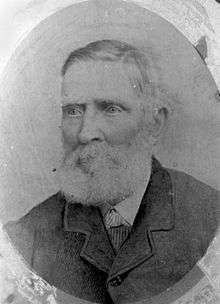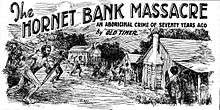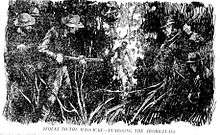Hornet Bank massacre
The Hornet Bank massacre of eleven Europeans (including seven members of the Fraser family) was one of direct retaliation to the deaths of twelve Yeeman people by member(s) of the Fraser clan. It took place about one or two o'clock on the morning of the 27 October 1857 at a station on the upper Dawson River (now Eurombah) in central Queensland, Australia.[1] It unfortunately spurred a much greater third massacre (led by William Fraser). It is believed that as many as 300 Aborigines may have been murdered in counter-retaliation, by both police and European squatters of the area. Indiscriminate attack against all and any Aborigines found within a wide radius of the station followed, including women, children and the elderly. The result was the extermination of the entire Yeeman tribe and language group by 1858, one year later.[2][3]
Background

Squatters had begun to occupy Yeeman land from 1847 following Ludwig Leichhardt's 1844-45 journey through the area on his expedition to find an overland route to Port Essington on the north coast of Australia.
The westernmost European "land grab" of the area was named Hornet Bank station, seized by Andrew Scott, who arrived in the early 1850s. In 1854 he leased the station to Scottish-born John Fraser who took his wife, Martha, and a large family ranging in age from young children to the early twenties, to live in this area, isolated from other European settlement. Two years later John Fraser died of dysentery while on a droving trip to Ipswich and his eldest son, William, then aged 23, took over management of the station in collaboration with the lessee, Andrew Scott.[4] (1)
The stations on the Dawson River were on the land of the Yeeman people who bitterly resented the invasion of these European squatters, who were attempting permanent residency without permission or negotiation. With their flocks of sheep and herds of cattle, to the Europeans the Yeeman were an impediment to the expansion of their pastoral empires. Disrespect and then regular cruelty towards the Yeeman people inflamed their already overwhelming sense of injustice, being barred access to their area. They made the surrounding country dangerous for the European migrants. Shepherds in boundary huts were attacked and killed and settlers feared leaving their wives and children unprotected.[5] Although contemporary reports of the events stressed the bloodthirsty nature of the Yeeman, contrasted with only kindness shown to them by the Fraser family, it has been claimed that the killing of the Frasers was in retaliation for the recent deaths of 12 Yeeman shot for spearing some cattle and for the deaths nine months earlier of an unknown number of Yeeman who had been given a strychnine laced Christmas pudding, allegedly by the Fraser family.[2][3]
Yeeman attack

The Yeeman attacked the Fraser homestead between one or two o'clock in the morning of the 27 October 1857. Those in the house were Martha Fraser, eight of her nine children, Henry Neagle (their tutor), two white station hands, who lived in a hut 1 km from the station and Jimmy, an Aboriginal servant. The evening before the attack, Jimmy, persuaded to collaborate, had killed all the station dogs. By all accounts, the Yeeman initially intended to kidnap one of the Fraser women but things got out of hand after the first Fraser to confront them was killed. The attackers killed the men, castrated Neagle, raped the three oldest women, clubbed them and the remaining children to death and speared to death the two station hands as they arrived to wash up before retiring for the night.[6]
The only survivor was fourteen-year-old Sylvester "West" Fraser who, after being hit on the head with a waddy had fallen between the wall and bed. The Aboriginals were distracted by the arrival of the two station hands, allowing Sylvester to crawl under his mattress and he was forgotten. Sylvester later ran "without hat or boots and in a terribly bruised state" 12 miles (19 km) to nearby Cardin Station and raised the alarm. Station hands immediately formed a posse and located a large mob of Aboriginals sleeping some 10 miles (16 km) from the Fraser property. They showed them no mercy, the first of many massacres to occur over succeeding weeks.[7]
Killed
.jpg)
The victims were buried on the property.[8]
- Martha Fraser, aged 43 years
- John Fraser, aged 23
- Elizabeth Fraser, aged 19
- David Fraser, aged 16
- Mary Fraser, aged 11
- Jane Fraser, aged 9
- James Fraser, aged 6
- Charlotte Fraser, aged 3
- Henry Neagle (tutor), aged 27
- R. Newman (shepherd), aged 30
- Ben Munro (shepherd), aged 45
- Jimmy (Indigenous houseboy)
William Fraser

The most ruthless avenger was William Fraser who was away in Ipswich at the time of the massacre. His brother Sylvester rode to Ipswich to inform him of the massacre and the pair returned to Hornet Bank, covering the 320 miles (510 km) in three days with three changes of horses.[7] Allowed to ride with the Native Police, William Fraser had 'every opportunity to assuage his grief through murder.' He continued killing randomly wherever he found Aborigines. He shot an Aboriginal jockey at the racetrack in Taroom and after two Aboriginals accused of being involved in the massacre were found not guilty he shot both dead as they left the Rockhampton courthouse. It was reported that after Fraser shot an Aboriginal woman in the main street of Toowoomba because he claimed she was wearing his mother's dress, two policemen spoke with him briefly before saluting and walking away. This incident reinforced a local belief that the Government had given him twelve months' immunity from prosecution, during which he was free to avenge the massacre of his family.[6] In 1905, Fraser was asked if he had an authority, he replied "I never asked and never received such an authority but felt I was justified in doing so (the killings)."[9]
Fraser later accepted a commission in the Rockhampton native police force but continued his campaign against the Yeeman.[6] It was later reported that in 1867, ten years after the massacre, lieutenant William Fraser and his troopers were tracking a small group of Yeeman women and children who had taken refuge on Mackenzie Station on the Fitzroy River. Informed that Fraser was approaching, Mrs Mackenzie hid the Aboriginals in her bedroom. Fraser demanded to search the house and did so but Mackenzie stood in front of the bedroom door and refused to allow him to search that room. Fraser left empty handed after Mackenzie gave him "all the contents of her tongue."[10]
William Fraser almost certainly killed over 100 members of the tribe making him one of the greatest mass murderer in Australian history. Many more were killed by sympathetic squatters and policemen.[3][11] In an article recounting the massacre, it was reported that the mere mention of Frasers name by settlers was enough to avoid trouble when they faced "truculent natives."[6]
Aftermath
_-_closeup.jpg)
How many people died as a result of the Yeeman avenging their own is unknown, but few Yeeman survived. Some managed to flee to Maryborough (300 km east of Taroom), but even there they were unsafe. The police continued harassing them for a number of years after. Fraser's revenge campaign eventually resulted in the extermination of the Yeeman tribe and language. By March 1858 up to 300 Yeeman had been killed. Public and police sympathy for Fraser was so high that he was never arrested for any of the killings and gained a reputation as a folk hero throughout Queensland.[3]
Sylvester Fraser never recovered either physically or mentally. He remained subject to fits, during which "blacks fled from him in alarm" despite him being harmless. It was reported that he died a broken man.[6]
William Fraser died at the age of 83 in Mitchell, Queensland on 1 November 1914. Noting that he left behind two sons and 14 daughters, his obituary stated that "Any blacks that crossed Fraser's path for many years after [the massacre] got a particularly bad time; in fact, the name of Fraser was quite sufficient to strike fear and terror into their hearts."[12]
In October 1957, to commemorate the centenary of the killings, a concrete memorial was erected on the grave site by Andrew Scott's descendants.[8]
On 18 September 2008, the grave site and memorial were added to the Queensland Heritage Register on 18 September 2008.[13]
See also
References
- ↑ Queensland State Archive NSW,COL/57/4329 report from Land Commissioner Wh Wiseman dated 'Cockatoo station November 16th 1857'.
- 1 2 Reid, Gordon: Nest of Hornets: The Massacre of the Fraser Family at Hornet Bank Station, Central Queensland, 1857, and Related Events, Melbourne: Oxford University, 1982 ISBN 0-19-554358-0
- 1 2 3 4 Bruce Elder: Blood on the Wattle: Massacres and maltreatment of Aboriginal Australians since 1788, New Holland Publishers, 1998, p.94, ISBN 1-86436-410-6
- ↑ Clarke, Patricia. Turning fact into fiction: the 1857 Hornet Bank massacre, M A R G I N: life & letters in early Australia.
- ↑ North Australian (Ipswich), 1 Sept 1857, p3 (editorial).
- 1 2 3 4 5 Murphy, J.E. (25 November 1950). "When Red Morning Came to Hornet Bank Station". The Courier-Mail. Brisbane, Australia. p. 2.
- 1 2 Hurd, Reginald (1 February 1919). "The Hornet Bank Massacre". The Queenslander. Brisbane, Queensland. p. 29.
- 1 2 "Fraser family grave site and memorial, Hornet Bank (entry 602075)". Queensland Heritage Register. Queensland Heritage Council. Retrieved 1 August 2014.
- ↑ Stewart, James (15 April 1905). "The Hornet Bank Tragedy". The Queenslander. Brisbane, Australia. p. 8.
- ↑ Bird, J.T.S. (9 February 1924). "Sixty Years in Queensland". The Capricornian. Rockhampton, Queensland. p. 14.
- ↑ Taroom Small rural service centre, The Sydney Morning Herald February 8, 2004
- ↑ "Obituaries". The Queenslander. Brisbane, Queensland. 14 November 1914. p. 14.
- ↑ "Fraser family grave site and memorial, Hornet Bank (entry 602075)". Queensland Heritage Register. Queensland Heritage Council. Retrieved 1 August 2014.
Further reading
- Laurie, Arthur (1957-01-01), Hornet Bank massacre : October 27, 1857, Royal Historical Society of Queensland, retrieved 26 August 2016 — full text available on-line via the University of QueenslandCoordinates: 25°45′S 149°24′E / 25.750°S 149.400°E
External links
![]() Media related to Hornet Bank massacre at Wikimedia Commons
Media related to Hornet Bank massacre at Wikimedia Commons